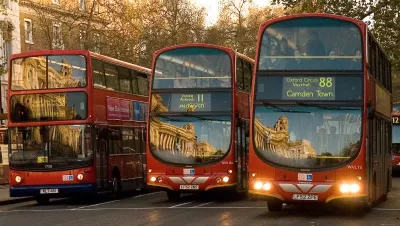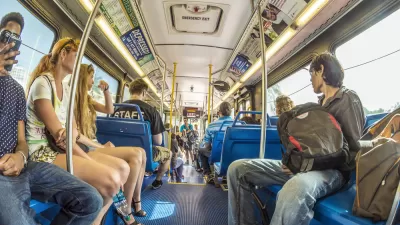The latest from China: a concept for street-straddling buses that cars could pass underneath. The giant vehicles could improve worsening traffic and already-dire pollution levels, taking the place of many conventional buses.

In case you missed it, a new transportation concept promises to ease traffic and lower pollution all at once. Linda Poon writes, "Participants at the 19th International High-Tech Expo in Beijing [...] watched excitedly as a tiny 'straddling bus' gobbled up cars and spit them back out as it glided above the traffic in a model city. It's a replica of what could be the future of China's public transport."
While it has been labeled a bus, the vehicle runs on tracks on either side of the road. Its potential passenger capacity is striking. "The bus would span two traffic lanes and carry up to 1,400 passengers. It would travel up to 40 miles an hour above street level on a special track, allowing regular cars under 7 feet high to freely pass underneath."
"The idea, while innovative, isn't new. As TreeHugger pointed out, two architects—Craig Hodgetts and Lester Walker—dreamed up a similar concept back in 1969 as part of their 'immodest proposal' for redesigning New York City." But their concept never became anything more than that.
Look forward to more developments this July or August, when the Chinese company Transit Explore Bus plans to test a life-sized model in the city of Changzhou.
FULL STORY: Can China's Futuristic 'Straddling Bus' Finally Become a Reality?

Alabama: Trump Terminates Settlements for Black Communities Harmed By Raw Sewage
Trump deemed the landmark civil rights agreement “illegal DEI and environmental justice policy.”

Planetizen Federal Action Tracker
A weekly monitor of how Trump’s orders and actions are impacting planners and planning in America.

The 120 Year Old Tiny Home Villages That Sheltered San Francisco’s Earthquake Refugees
More than a century ago, San Francisco mobilized to house thousands of residents displaced by the 1906 earthquake. Could their strategy offer a model for the present?

In Both Crashes and Crime, Public Transportation is Far Safer than Driving
Contrary to popular assumptions, public transportation has far lower crash and crime rates than automobile travel. For safer communities, improve and encourage transit travel.

Report: Zoning Reforms Should Complement Nashville’s Ambitious Transit Plan
Without reform, restrictive zoning codes will limit the impact of the city’s planned transit expansion and could exclude some of the residents who depend on transit the most.

Judge Orders Release of Frozen IRA, IIJA Funding
The decision is a victory for environmental groups who charged that freezing funds for critical infrastructure and disaster response programs caused “real and irreparable harm” to communities.
Urban Design for Planners 1: Software Tools
This six-course series explores essential urban design concepts using open source software and equips planners with the tools they need to participate fully in the urban design process.
Planning for Universal Design
Learn the tools for implementing Universal Design in planning regulations.
Clanton & Associates, Inc.
Jessamine County Fiscal Court
Institute for Housing and Urban Development Studies (IHS)
City of Grandview
Harvard GSD Executive Education
Toledo-Lucas County Plan Commissions
Salt Lake City
NYU Wagner Graduate School of Public Service





























